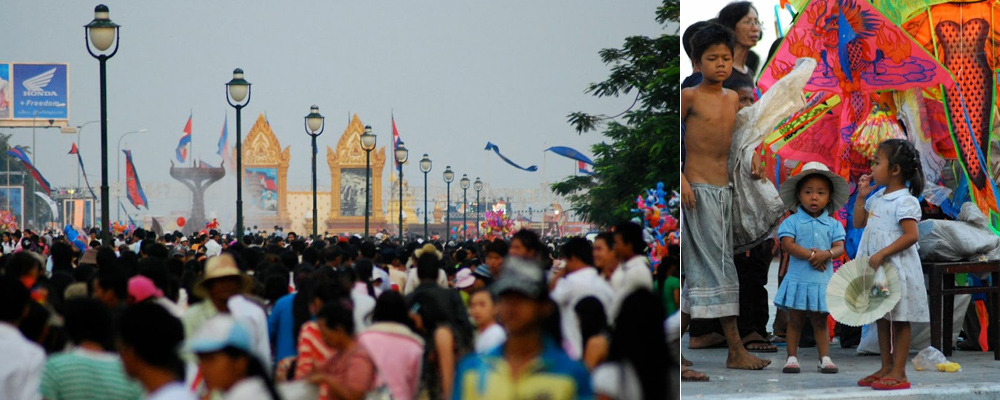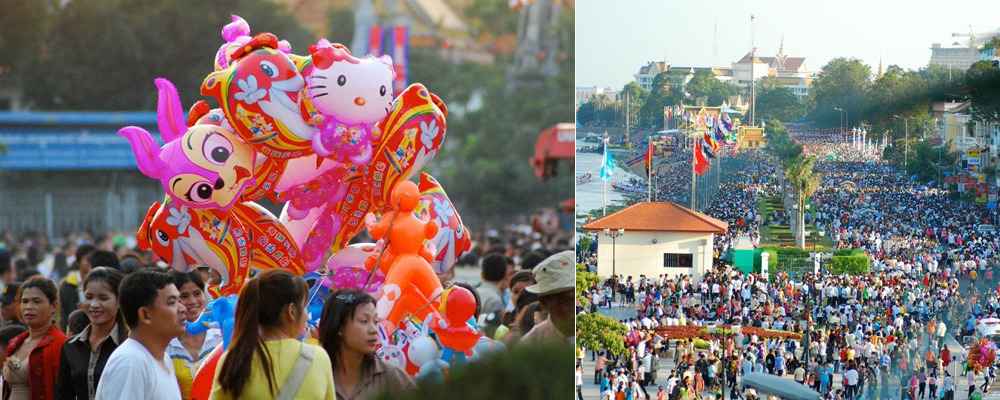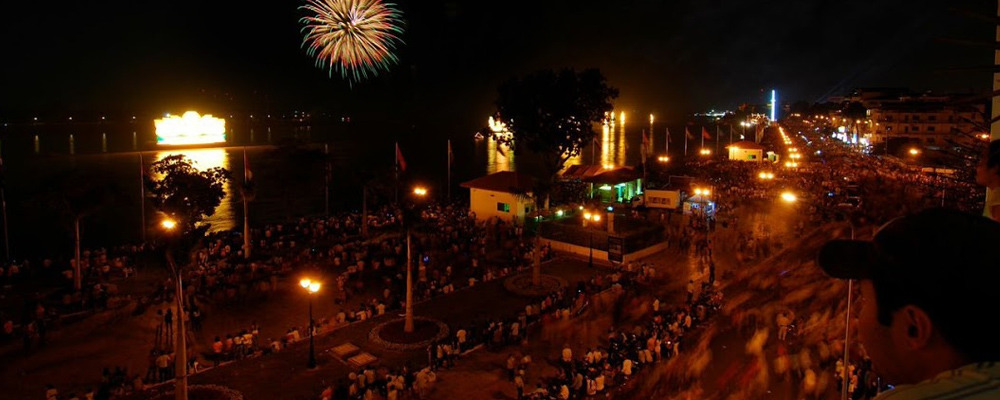Experience Phnom Penh for Bon Om Touk
Emily Manthei
The provincial capital of Cambodia, Phnom Penh is a city that feels more like a small town. Instead of seeing bustling traffic and harried pedestrians begging tourists for cash (which can be found in neighboring Thailand), you’re more likely to discover moseying motorized “tuk-tuks” and “remorks,” slowly pedaled “cyclos” or a street-side barber napping in his chair. Even the world’s coffee shop trend hasn’t interrupted the city’s leisurely pace: to-go orders are non-existent, so you can sit at a table and watch the world go while you wait for the caffeine you’ve been craving. And the Khmer language, with its lulling clucks punctuated by “mmms” and “aaaahs,” adds to the city’s slow-burn lifestyle. The “Kingdom of Kampuchea” is a city where you’re more likely to hear birds and wind than the honking horns and hurried construction found in so many other developed South Asian capitals.
Cambodians have good reasons to take it slow on the development and lifestyle fronts, as the nation has experienced a roller coaster of crises and tragedies in the 20th century. The destructive era of the Khmer Rouge, responsible for the execution and starvation deaths of nearly two million people (almost 25 percent of Cambodia’s population), and its bitter aftermath have taken a generation to subside but the memories still haunt citizens. In new era of peace, Cambodians aren’t rushing to catch up to the West with a global paradigm. Instead they’re focused on the present and taking things day by day, moon cycle by moon cycle.
November’s full moon brings one of Cambodia’s major festivals of the year. Bon Om Touk celebrates the end of the Tonle Sap’s river flooding season and the return of its directional flow into the Mekong Delta. During summer’s rainy season, the river becomes so swollen that its natural path reverses and overflows into Tonle Sap’s lake. As the swelling dissipates in November, the river’s original flow resumes while bringing copious quantities of fish from the lake. This bountiful reversal of fortune is celebrated in Cambodian cities all along the river. There’s a public water festival complete with rowing races, parades and fireworks along the Sisowath Quay in Phnom Penh. The festival has been canceled due to flooding every year since the 2010 Bon Om Touk stampede, a freak disaster that cost hundreds of lives, but Prime Minister Hun Sen is now ready to have Phnom Penh return to form and go into festival-mode.
DO:
Beyond the Sisowath Quay riverfront, where you’ll experience Bon Om Touk, the must-see locations in Phnom Penh are blissfully limited. Most of the city’s enjoyments are best experienced by casual wandering. After an obligatory visit to the glam Buddhist temple the Silver Pagota, a slow ride through the city’s architectural landmarks is the only other primer needed for self-guided discovery. On the weekly Khmer Architecture Tours, taken by foot and by cyclo, see where the beautiful French-Colonial architecture (at its prime during the Beaux Arts and Art Deco periods) meets the modern Khmer architecture achieved after Cambodia’s independence. These tours give visitors an inside look at the makeup of Phnom Penh, including the magnificent Psar Thmai or Central Market, an Art Deco masterpiece perfect for finding knock-offs and traditional Cambodian treasures. Check out the Russian Market for obligatory trinkets and the Night Market for a hip “art walk” vibe. And for high-quality, locally made jewelry, visit Sit Down Jeweler near the Royal Palace.
Find out where young, cosmopolitan Cambodians experience the outside world at the Meta House, a bar and small cinema run by the German-Cambodian Cultural Center. It generously offers German and Western art exhibitions, political talks like TEDx, and independent Cambodian and international films (most public presentations are in English). Similarly, the French Institute of Culture presents film and art programs (mostly in French) that reinforce France’s cultural ties with Cambodia while creating new ones. There’s also Empire Cinema, an art-house cinema with an adjoined restaurant/bar. With its comfy mini screening room on the second floor of a beautiful colonial building, this collaboration from a British expat and Cambodian chef mixes classic Hollywood cinema with foreign indie productions and new Cambodian works. Lest we forget about Cambodia’s history, the theater has daily screenings of “The Killing Fields.” And no one can leave Phnom Penh without a daily massage — and with prices ranging from $7 to $15, why not? Visit Seeing Hands Massage, where blind masseuses will knead out all your pressure points.
EAT:
If you don’t start your day with hotel breakfast (which is hard to imagine), ARTillery Café is the next best thing. The central-city coffee house is where art, cafe and community collide while offering a contemporary Western breakfast. In Phnom Penh you’ll also find many businesses that train rural Cambodians for city-style careers, including the charity Tree Alliance and its several restaurants that have Cambodian chefs-in-training at the helm. Friends is the charity’s daytime eatery while Romdeng is a classy evening joint, and both serve tasteful, modern takes on Cambodian fare. For Asian-fusion style dining along the riverfront’s Bon Om Touk action, Metro Hassakan is perhaps Phnom Penh’s best-known Cambodian restaurant. And Malis is your date-night dining option, complete with a wine cellar and seasonally changing menu.
For those who espouse the saying “When in Rome…,” try mastering the use of the traditional Cambodian spice “amok” (also the name of the national dish) and other locally grown spices. Sample the most potent black pepper you’ve ever eaten when learning the art of Khmer cuisine at Cambodian Cooking Class. Thanks to that robust Tonle Sap river flow, plentiful market veggies and fish can complete your ingredient list.
Of course, Phnom Penh’s other major culinary influence is colonialism. If your tastes tend “à la Française,” you’ll find plenty of great options. On the homey side, Comme a la Maison has hearty, provinçial French fare, while Deco offers more of a brasserie menu with a stylized Art Deco look. And Topaz and La Residence both provide upscale atmosphere with classic French cooking tinged with Cambodian influences.
DRINK:
Phnom Penh’s relaxed lifestyle doesn’t necessarily make for big parties or all-night bar scenes, but the city does provide a few night-life musts. The historic Elephant Bar inside the Raffles Hotel has been the place to see and be seen for every 20th century journalist, development worker and government expat employee for the past 100 years. The bar’s intricately carved elephant columns invoke a world somewhere between Indiana Jones, Ernest Hemingway and Hunter S. Thompson. For a 21st century version of Raffles/Elephant, the Quay is a boutique hotel with the rooftop bar Chow, which oozes the same minimalist cool as the Roof on Wilshire without the Elephant Bar jungle-fever quirkiness. To understand the real vibe of Phnom Penh, where expats and locals are equally comfortable, dive into the city’s most popular club Heart of Darkness. While the place has had a long-standing ban by U.S. Embassy employees (who knows why?), it’s pretty clear that they’re the only ones missing out on the party.
STAY:
From backpacker hostel to boutique hotel, life in Phnom Penh is characterized by its affordable luxury. Eighty8 Backpackers is a slick, luxe crash pad with deluxe private rooms that go for $24 a night. For about $60 a night, try the Blue Lime, a budget boutique hotel with “private plunge pools” in some of the rooms, and Villa Langka, a relaxed, tree-lined oasis in a former colonial house. New arrivals in the hotel sector get increasingly sleek. The Tea House is a moody, mid-century-designed hotel with a tea theme and single rooms that go as low as $40 a night. The winner in the classy, modern category is the aforementioned Quay. Located along the riverfront, the hotel is as uber-chic as they come with prices ranging from $70 to $100 a night. La Maison d’Ambre is a chicly high-end hotel conceived by a Cambodian-French fashion designer with a flair for Asian cinema, and prices top out at around $200 a night. And we can’t forget Raffles Hotel (of Singapore Sling fame), a 1929 luxury gem with colonial architecture that’s hosted royalty and dignitaries for almost 100 years in Phnom Penh. Swanky? Yes, as prices start around $200.
Bon Om Touk takes place in Nov., dates change annually.



